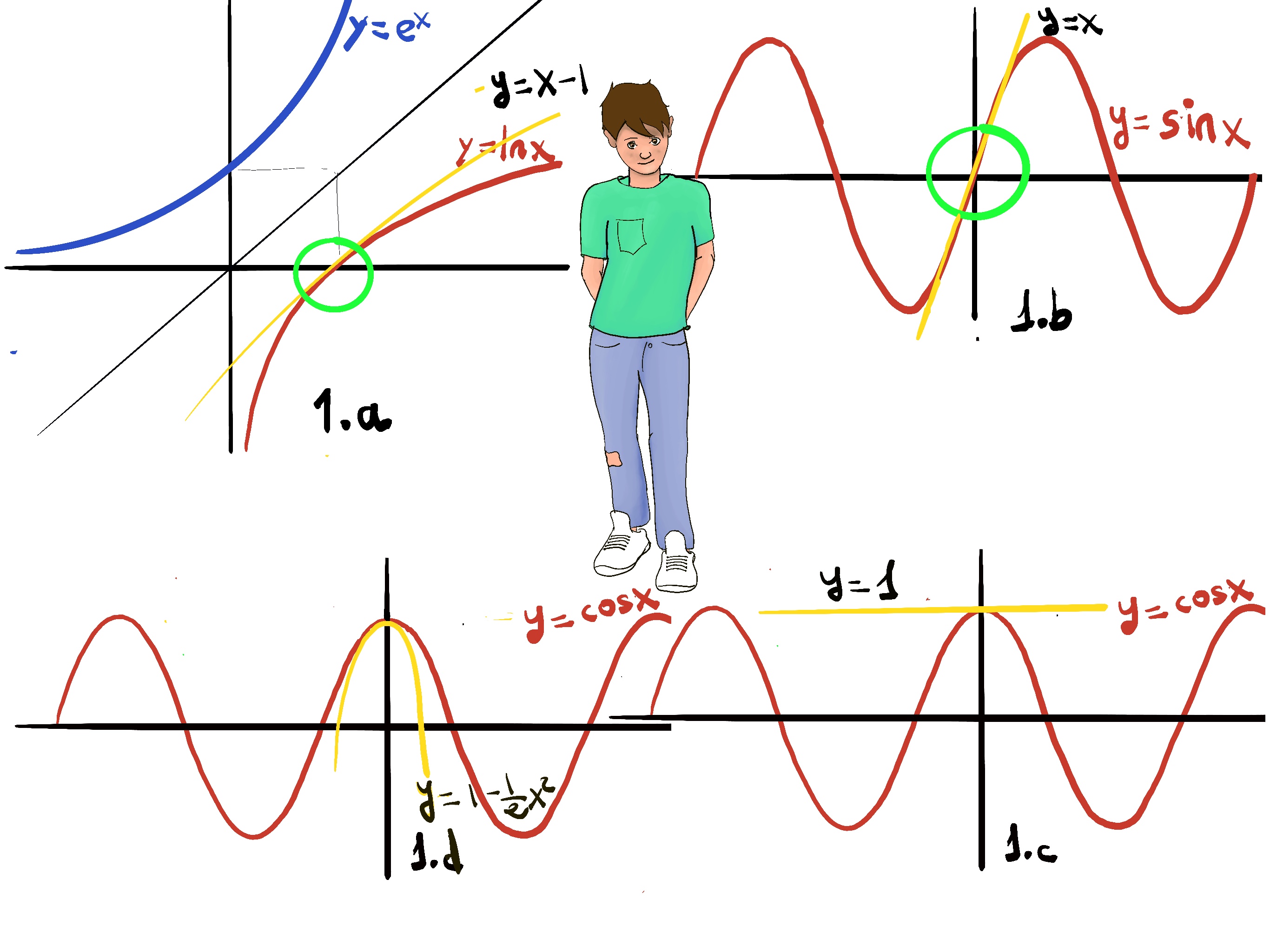
|
 |
 |

|
 |
 |
An old joke that Adam told to Even, but makes cents, Once a man said to God “What’s a million years to you?”, and God said “A second.” So the man said to God “What’s a million dollars to you?”, and God said “A penny.” So the man said to God “Would you give me a penny?” And God replied, “Sure, just wait a second.”
Definition. A function f is a rule, relationship, or correspondence that assigns to each element of one set (x ∈ D), called the domain, exactly one element of a second set, called the range (y ∈ E).
The pair (x, y) is denoted as y = f(x). Typically, the sets D and E will be both the set of real numbers, ℝ.
Linear and quadratic approximations are methods used to approximate a complicated function with simpler, linear or quadratic functions near a specific point. This is useful when the exact value of the function at that point is difficult to calculate, computationally costly, or tedious to find. These approximations are valuable in calculus and numerical analysis for estimating the behavior of functions near certain points or for simplifying calculations.
Linear approximation does a very good job of approximating values of f(x) as long as we stay near x = a, that is, in the neighborhood around a. If a function y = f(x) is differentiable at a point (a, f(a)), the function looks like its tangent line in a small open interval containing a. It allows us to approximate the original function f (it is sometimes computationally too costly -in terms of resources- or algebraically complicated) with a simpler function L that is linear.
The tangent line is f(x) = f(x0) + f’(x0)(x-x0) and touches the curves at this particular point (x0, y0)
Let x0=1, e.g., $x_0=1, ln(1) = 0, ln’(x)=\frac{1}{x}, ln’(1)=\frac{1}{1} = 1$⇒ lnx ≅ x - 1 (-Figure 1.a.-)
Let x0=0, f(x) = f(0) + f’(0)(x). Other examples are:
(1+x)r, f(x) ≅ f(0) + f’(0)(x) = 1 +r(1+x)r-1|x=0·x = 1 + rx,, e.g., x = 0, r = 3, (1+0.1)3 = 1.331 ≅ 1 +3·(0.1) = 1.3. The approximation yields 13, which is close to the actual value of 1.331.

So let f(x) = $\sqrt[4]{x}$. Obviously, 1 is relatively close to 1.1 and we take x0 = 1. Then, the tangent line is y = f(x0) + f’(x0)(x -x0) =[f’(x)=$\frac{1}{4x^{\frac{3}{4}}}, f’(1)=\frac{1}{4·1^{\frac{3}{4}}}=\frac{1}{4}$]
$\sqrt[4]{1.1} = 1.024114… ≈ \sqrt[4]{1}+\frac{1}{4}(1.1 -1) = 1+\frac{1}{4}·0.1 = 1.025.$
$\frac{e^{-3x}}{\sqrt{1+x}} = e^{-3x}(1+x)^{-1/2} ≅ (1-3x)(1-\frac{1}{2}x) ≅~ 1 -3x -\frac{1}{2}x +\frac{3}{2}x^{2} ≅ 1 -3x -\frac{1}{2}x ≅ 1 -\frac{7}{2}x$. Observe that we do not care about quadratic and higher other terms and consider them as negligible as long as we are close enough to 0.
Besides, $e^x = 1 +x ⇒ e^{-3x} ≅ 1 +f’(0)x = 1 + (-3x)$. Similarly, (1+x)-1/2 ≅ 1 + f’(0)x, and f’(0) = -1/2(1+x)-3/2|x=0 = -1/2, hence (1+x)-1/2 ≅ 1 + -1⁄2x
The challenging limit $\lim_{x \to 0} \frac{sin(x)}{x}$ is an indeterminate form (0/0). It is easy to show that the linearization of f(x) = sin(x) at the point (0, 0) is given by x, hence for values x near 0, sin(x)≈ x, and therefore $\frac{sin(x)}{x}≈\frac{x}{x} = 1$ which makes reasonable the fact that $\lim_{x \to 0} \frac{sin(x)}{x}$ =1.
When using approximation you sacrifice some accuracy for the ability to perform complex calculations easily and fast. Quadratic approximation is used when the linear approximation is not good or close enough. The basic formula for quadratic approximation with x0 is:
f(x) ≅ f(x0) + f’(x0)(x-x0) + f’’(x0)⁄2(x-x0)2, and this is generally enough for x ≅ x0.
It gives a best-fit parabola to a function. Ideally, the quadratic approximation of a quadratic function, say f(x) = a +bx +cx2 should be identical to the original function.
f(x) = a +bx +cx2
f’(x) = b + 2cx
f’’(x) = 2c
Set the base x0 as zero. Next, we try to recover the values of a, b, and c.
f(0) = a
f’(0) = b
f’’(0) = 2c ⇒ c = f’’(0)⁄2
f(x) ≅ f(x0) + f’(x0)(x-x0) + f’’(x0)⁄2(x-x0)2 where x ≅ x0, say x = 0, hence f(x) ≅ f(0) + f’(0)(x) + f’’(0)⁄2x2 where x ≅ 0, f(x) ≅ a +bx + 2c⁄2x2 = a +bx +cx2
The linear approximation of cosx near 0 is the straight horizontal line y = 1. This doesn’t seem like a very good approximation. The quadratic approximation to the graph of cos(x) is a parabola that opens downward, cosx ≅ 1 -1⁄2x2 (1.d.), this is much closer to the shape of its graph than the line y = 1.
f(x) ≈ $f(x_0)+f’(x_0)(x-x_0)+\frac{f’’(x_0)}{2}(x-x_0)^2$.
Let f(x) = ln(x), x0 = 1, f’(x) = $\frac{1}{x}, f’’(x) = \frac{-1}{x^2}$.
ln(1.1) = $ln(1+\frac{1}{10}) ≈ ln(1)+\frac{1}{1}(1+\frac{1}{10}-1)+\frac{-1}{2·1^2}(1+\frac{1}{10}-1)^2 = \frac{1}{10}-\frac{1}{2}\frac{1}{100}=0.095$
f’(x) = $\frac{1}{2\sqrt{x}} = \frac{1}{2}·x^{\frac{-1}{2}} =$ , f’’(x)= $\frac{1}{2}·\frac{-1}{2}·x^{\frac{-1}{2}-1} = \frac{-1}{4·x^{\frac{3}{2}}} = \frac{-1}{4·x·\sqrt{x}}$, then
f(1)=e-2
f’(x)=e-2x-2xe-2x=e-2x(1-2x) ⇒ f’(1)= -e-2
f’’(x)=-2e-2x-2e-2x(1-2x)=-2e-2x(2-2x)=-4e-2x(1-x) ⇒ f’’(1)=0.
f(x) ≅ e-2 -e-2(x-1)
$e^{-3x}(1+x)^\frac{-1}{2} ≅ (1 -3x + \frac{9x^{2}}{2})(1 +\frac{-1}{2}x + \frac{3}{8}x^{2}) ≅ 1 -3x + \frac{9x^{2}}{2} +\frac{-1}{2}x + \frac{3}{2}x^{2} + \frac{3}{8}x^{2} ≅ 1 +\frac{-7}{2}x + \frac{51}{8}x^{2} $ 💡O(x3) ≅ 0.